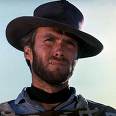











|
The Western or the cowboy movies have been with us since the birth of the movies. It is the longest lasting genre of films. Their popularity has its ebbs and peaks but it is always popular. Click here to read reviews or submit your own. We always need original reviews. As we stated elsewhere on this site, there are two main categories of Westerns, those with Indians and those without. In the early movies, the Indians were portrayed as savages who were not that bright and were easily let by criminal white gun runners or an evil Indian chief. For example Telegraph Trail which starred John Wayne is a good example of this kind of movie. None of the Indians are bright. They are misled by a white tycoon and, of course, they are defeated by a few clever white settlers Since most of these films were made in the thirties and forties, the dialog and the characterization is somewhat closer to the facts as people knew it then since many of the advisors and bit players were old time Indian fighters or law men. There was far less compassion in those movies. The bad guys are really bad and they will not blink at throwing a kid out of a window to intimidate a settler. Again that may be closer to the truth since life was hard in the old West. After the 1960's when political correctness became fashionable, the pendulum swung the other way. The way Colonel Custer was treated is a good example of the change in attitudes. In the early days, Errol Flynn played Custer was treated as an outstanding hero and the Indians as dumb warriors. Even Custer's horse was treated with reverence in the 7th Cavalry (1956) with Randolph Scott. Then in Custer of the West with Robert Shaw in (1967), Custer was depicted as an opportunist. The Indians suddenly became wise men in tune with nature and victims who were mistreated by the army, and the white settlers who were stealing their lands. Dances with Wolves (1990) is another example of the latter. |
|||||||||
|
The truth is probably somewhere in between. As in any groupings of people there were good Indians and bad Indians. There were Indians who built the intricate buildings in New Mexico and Arizona and then there were the Apaches who took the white man's methods for torture and improved upon it. To give credit to the Indians, in general, it is true that our ancestors stole the land from them. However, apparently they also took it from the original indigenous people who were living in this continent in the first place. We should review some important concepts here about the Westerns. Rule number one in the Cavalry school was to shoot at the largest target. In fact, it is a rule in any kind of hostile engagement. So, what will you do if you are hiding behind some rocks in a gully and are being attacked by Marauding Indians? Well, you will notice that in these movies nobody shoots at horses. They try to shoot the riders who are constantly moving and are possibly hiding on the back of the horse. Big mistake! Shooting at the horse provides the biggest advantage. One is that it is the biggest target especially in broadside. Even a child with a slingshot couldn't miss it. The second reason is that if you hit the horse the rider will fall and may be killed or injured seriously. In any case he is now dismounted and cannot attack you or maneuver at high speed as before. Chances are he will run away. Another myth. A bunch of cut throat robbers or to call them correctly by their old names road agents attack a stage coach. They make life very difficult for themselves by trying to shoot the driver who eventually falls down but the horses keep on going. The robbers have no compunction about killing the people but they do not shoot at the horses. Yet again, here the broadest targets are the horses, at least four or maybe eight of them. Just hitting one of them would stop the coach cold in its tracks. No need to get up a sweat running and chasing after a fast running coach. Another lesson in Indian fighting. Rifles are not always better than bows and arrows in a battle. The rifle has the greater range and is more destructive. However, it basically can only shoot straight ahead. The arrow can be shot into the air and will come down with the same speed down a trajectory on the opposite side to where you shot it into the air. So if you are Indians encircling a wagon train, you could shoot with your rifles at the people who are hiding behind the wagons and chests and barrels and cargo and maybe hit some of them but you will also be shot at. Instead you can shoot into the air above them and once you get the range, the arrows will come down inside the circle and will decimate anybody moving around or hiding behind objects. You do not even have to come out of hiding to shoot your arrows. The great John Ford made several notable movies with cavalry and Indians as the main theme. In For Apache (1948) Henry Fonda plays Colonel Thursday, who taunts Cochise by calling him a man without honor to his face and then thinks that the Indians are stupid and do not have a clue about how to trap his troops. Rid Grande (1950) was another movie about the battle with the Apaches. This time, in addition to the Apaches, John Wayne had to cope with his estranged wife Maureen O'Hara and also about having his son as a young trooper under his command. She Wore a Yellow Ribbon (1950) was perhaps John Ford's best. Again it starred John Wayne, this time as an old soldier about to retire and be put out to pasture. There is, of course, the danger of an Indian uprising looming in the horizon. The other category that we would like to generalize under the Adventure/Drama Western was basically developed with some suspense and drama. |
|||||||||
Occasionally, some of these films became outstanding movies such as the Ox-bow Incident (1943), Shane (1953), High Noon (1952), the Gunfighter (1950) with Gregory Peck and more recently the Unforgiven (1992). I must say that after making many B and C Westerns, Clint Eastwood recognized his potential and made this marvelous Oscar winning movie. Then there was a lot of garbage such as singing cowboy movies by Gene Autry and the like. John Wayne, in the 1930's appeared in many of these C movies even though he did not sing. Then there were the glamour garbage movies such as Butch Cassidy and the Sundance Kid (1969.) The writer, which I understand did not know anything about those two murdering villains made their characters into two misunderstood cowboys who were hounded by the Pinkerton detectives. The director George Roy Hill went along and added glamour and nice looking girls and a bicycle ride and made it into a block buster of sorts. If you have satellite or cable, you can see movies from every one of the categories mentioned above in the Western Encore channel. Some of the things that still intrigue me especially in the glamorous garbage is how did these people manage to look so elegant and neat. Imagine, the stars going on a chase across a desert or actually trekking to another destination. After six or seven days they still look fresh and clean shaven. The women have clean clothes on and are fully made up. And they even make love. The question I have is how did those people relieve themselves and clean afterwards. Paper was a very expensive and rare commodity then. So, how did they do it? These people must have stunk to high heaven after a few days. No wonder the Indians could find them easily. A woman friend of mine who was in the military in Iraq told me that after a few days of patrol without showers, everyone especially the women smelled badly. Now multiply those three days by 30 and you realize how hardy our pioneer ancestors must have been! Finally, the Italian Westerns deserve a mention here. There was a great artistic talent in Italy after World War II that was channeled into making some great movies. Italians, especially from Rome to the south had a great interest in movies and on average saw two movies every week. The movies were usually interrupted with live comedy, dancing and singing acts. Westerns and comedies were among the most successful movie types since they were escapists and did not try to address hard facts of life. From this environment Sergio Leoni became the most famous and prolific Western movie maker. His films became very popular in other countries including the United States. Sergio Leoni and other Italian directors managed to make stars out of Clint Eastwood, Lee Van Cleef and Charles Bronson. Other American stars with fading fortunes such as Henry Fonda and Jason Robards, shunned by Hollywood of the sixties and seventies managed to find work playing in these movies. Italian Westerns followed the same Hollywood formula of good versus evil. There was more sex and definitely much more violence in these movies as the Europeans did not have the same production code as the United States. Some of the famous movies of this era are, The Good, the Bad and the Ugly, Once Upon a Time in the West, For a Few Dollars More, Captain Apache and the Trinity series directed by Enzo Barboni and starring Terence Hill and Bud Spencer as two unlikely brothers. |